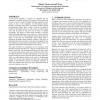411 search results - page 59 / 83 » Automatically finding patches using genetic programming |
ACMSE
2006
ACM
13 years 11 months ago
2006
ACM
A code clone represents a sequence of statements that are duplicated in multiple locations of a program. Clones often arise in source code as a result of multiple cut/paste operat...
BMCBI
2010
13 years 10 months ago
2010
Background: Genome-wide association studies have been successful in finding common variants influencing common traits. However, these associations only account for a fraction of t...
COMPSAC
2008
IEEE
14 years 4 months ago
2008
IEEE
1 Typical enterprise and military software systems consist of millions of lines of code with complicated dependence on library abstractions. Manually debugging these codes imposes ...
ERSHOV
2009
Springer
14 years 1 months ago
2009
Springer
A term t is called a template of terms t1 and t2 iff t1 = t1 and t2 = t2, for some substitutions 1 and 2. A template t of t1 and t2 is called the most specific iff for any template...
ICDE
2006
IEEE
14 years 11 months ago
2006
IEEE
Scheduling/prioritization of DBMS transactions is important for many applications that rely on database backends. A convenient way to achieve scheduling is to limit the number of ...

